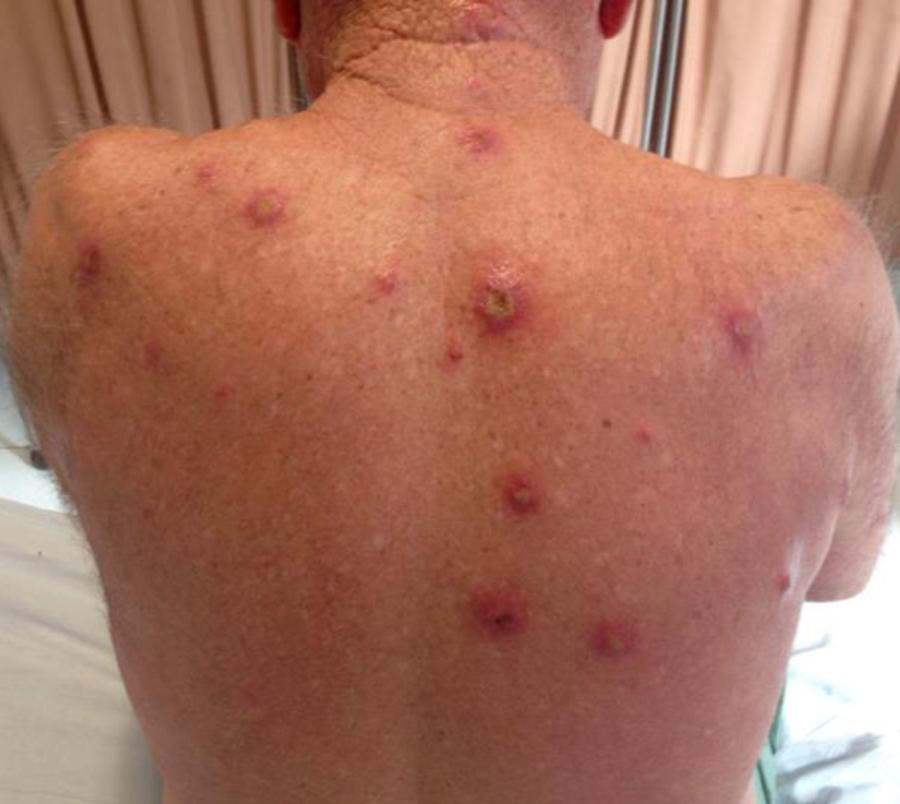A 69-year-old male patient, with history of multiple furuncles for two months, without improvement after the use of cephalexin and amoxicillin/clavulanate for 20 days, and daily fever for a week. On dermatological examination, multiple ulcerovegetative and ulcero-crusted cutaneous lesions on the face, ears, scalp, back, upper and lower limbs and genitalia were observed (Figs. 1 and 2). There was no lymphadenopathy. Based on the clinical picture the hypotheses of disseminated cutaneous leishmaniasis, paracoccidioidomycosis, and malignant syphilis were raised. Laboratory tests (blood count, renal function, hepatography, and coagulogram) were normal. Serology for hepatitis, syphilis, HIV, and Leishmania donovani were negative.
Multiple cutaneous ulcerovegetative and ulcero-crusted reddish lesions were observed on the ears, face, and scalp. Superficial involvement of mucosae was recognized on the nose.
Papules, nodules, infiltrated erythemas were found on the dorsum. Induration of the lesions was palpable.
Swabs taken from open lesions for direct mycological examination and culture for fungi were negative. Histopathological of the edge of an ulcer on the dorsum demonstrated dense lymphohistiocytic inflammatory infiltrate with plasma and mast cells, in addition to neutrophils and granuloma formation; hyperplastic skin surrounded with areas of pseudoepitheliomatous pattern. Giemsa and Ziehl-Neelsen staining were negative for fungi and acid-fast bacilli, respectively. Rounded and oval structures with kinetoplast, phagocytosed in macrophages were observed.
Based on clinical and histological picture of chronic ulcerated dermatitis associated with leishmanias, the diagnosis of disseminated cutaneous leishmaniasis was established, the treatment with meglumine antimoniate 20 mg/kg/day was started, and administered for 30 days. After 20 days of the end of treatment, there was healing of skin and mucosal lesions. He is in the ninth month of follow-up, with no appearance of new lesions and complications (Fig. 3).
Clinical cure after the treatment. (A) Absence of skin and mucosal lesions; (B) hypochromic-atrophic scars on the dorsum.
A negative serology for L. donovani came as no surprise, as this agent causes visceral leishmaniasis, with rare cases of skin lesions described in the literature.11 Bernardes Filho F, Bonatto DC, Martins G, Maier LM, Nery JAC, Azulay-Abulafia L. Occurrence of two autochthonous cases of American cutaneous leishmaniasis in the neighborhood of Caju, city of Rio de Janeiro, Brazil. An Bras Dermatol. 2014;89:848-850.,22 Gelanew T, Hurissa Z, Diro E, et al. Disseminated cutaneous leishmaniasis resembling post-kala-azar dermal leishmaniasis caused by Leishmania donovani in three patients co-infected with visceral leishmaniasis and human immunodeficiency virus/acquired immunodeficiency syndrome in Ethiopia. Am J Trop Med Hyg. 2011;84:906-912. Currently considered an emerging form of the disease,33 Vernal S, De Paula NA, Gomes CM, Roselino AM. Disseminated leishmaniasis by Leishmania viannia subgenus: a series of 18 cases in southeastern Brazil. Open Forum Infect Dis. 2016;3:ofv184. disseminated leishmaniasis should be detected early, recognizing its clinical spectrum and disabling potential.
References
-
1Bernardes Filho F, Bonatto DC, Martins G, Maier LM, Nery JAC, Azulay-Abulafia L. Occurrence of two autochthonous cases of American cutaneous leishmaniasis in the neighborhood of Caju, city of Rio de Janeiro, Brazil. An Bras Dermatol. 2014;89:848-850.
-
2Gelanew T, Hurissa Z, Diro E, et al. Disseminated cutaneous leishmaniasis resembling post-kala-azar dermal leishmaniasis caused by Leishmania donovani in three patients co-infected with visceral leishmaniasis and human immunodeficiency virus/acquired immunodeficiency syndrome in Ethiopia. Am J Trop Med Hyg. 2011;84:906-912.
-
3Vernal S, De Paula NA, Gomes CM, Roselino AM. Disseminated leishmaniasis by Leishmania viannia subgenus: a series of 18 cases in southeastern Brazil. Open Forum Infect Dis. 2016;3:ofv184.
Publication Dates
-
Publication in this collection
Mar-Apr 2017
History
-
Received
7 Oct 2016 -
Accepted
26 Oct 2016




